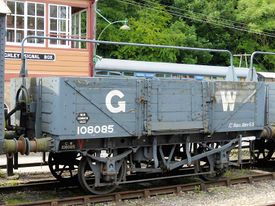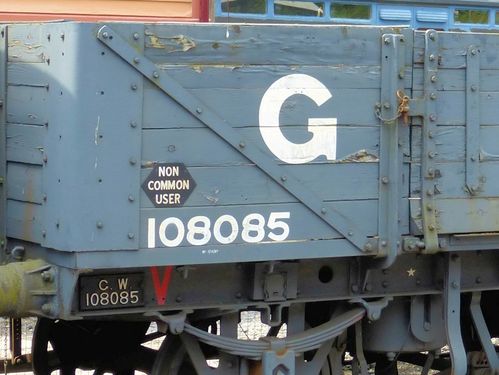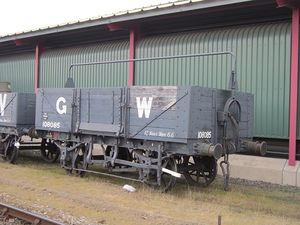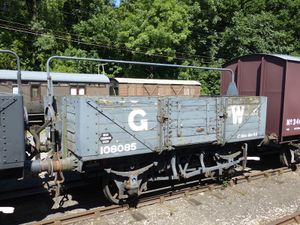GWR 108085 5 plank Open Goods Wagon
| GWR 108085 5 plank Open Goods Wagon | |
|---|---|
 GWR 108085 5 plank Open Goods Wagon | |
| Built By | GWR Swindon |
| Status | Awaiting repair |
| Number | 108085 |
| Other Numbers | PBA 58031 |
| History | |
| Built | 1925 |
| Diagram | O22 |
| Lot | 929 |
| Type | 4-w 5-plank Open |
| Capacity | 12 tons |
| Telegraphic code | OPEN B |
| Brakes | Vac fitted |
| 1982 | Arrived on SVR |
| 2002-03 | Major overhaul |
The earliest GWR open wagons were known as 'low-sided trucks' and had only a single plank. Construction switched to two-plank in 1872 using 11in planks, and to three-plank in 1879 using 7in planks which became more or less the standard as further planks were added to increase height. Four-plank open wagons appeared in the late 1880s and 5-planks in 1902. In 1904 the top 5th plank was widened to 11in which thereafter remained the usual configuration for GWR 10-ton (later 12- and 13-ton) open wagons.[1] During World War Two a scarcity of wide planks resulted in a modified 6-plank Diagram of the same effective height but with the top 11in plank replaced by a 7in and a 3½in plank.[2] This construction compromise can be seen on 108085 which is now a "5½-plank wagon".
108085 was one of 2,186 5-plank open wagons built at Swindon between 1924 and 1926 to Diagram O22. That Diagram included both OPEN A (non-vac) and OPEN B (vac fitted) versions, 108085 being one of 975 of the latter type.[3] The wagons were 16ft in length over the headstocks with a 9ft wheelbase and had a capacity of 12 tons. A central drop door on each side aided loading and unloading[4].
Contents
Service
108085 was built at Swindon in 1925 as part of Lot 929[note 1] which comprised 500 OPEN B.
108085 saw service with the GWR and later with BR's Western Region. After BR service it was sold to the Port of Bristol Authority where it was numbered PBA 58031.[5] While at the PBA the curb rail and vacuum brakes were removed[6].
Preservation
108085 was acquired for preservation by the The GWR 813 Preservation Fund. It arrived on the Severn Valley Railway on 19 February 1982 direct from Avonmouth Docks,[5] and was given a quick repaint into GWR livery soon after arrival.[7] In 1988 a broken drawgear spring needed replacement,[8] but otherwise it received no attention for the next twenty years apart from routine pads exams.
A full overhaul began in 2002. All the body timbers were considered beyond re-use and were removed. By September 2002 the chassis had been cleaned down and painted, and the bearing and journal condition checked. New material for the curb rail was obtained and fitted, while all the body timbers were also replaced; the planks being from a stock of second hand planks obtained some years earlier. The curb rail and vacuum brakes which had been removed during PBA ownership were reinstated. The wagon was repainted as normal; however the brackets required to reinstate the sheet support rail had been misplaced after being stored for safe keeping, so the vehicle was outshopped without it.[6]
Further work was required in June 2008. The brand of 'finish paint' used in 2003 was not showing good wearing properties in comparison with that used previously, while several of the second-hand planks used in the restoration had suffered from rot. The planks were therefore replaced and a further repaint carried out. After repainting 108085 was kept in Bewdley yard while the necessary parts were fabricated and assembled on site to allow the missing sheet support rail to be reinstated.[9]
The picture above gives a more detailed view of the construction and livery of 108085. A number of points may be noted:
- The red letter V on the solebar denotes that the wagon is vacuum–fitted. The small white star indicates the position of the 'string' which can be used to release the vacuum when required.
- Each solebar has two holes just inboard of the axleguards, one of which is visible in the picture. These allowed a rope to be fitted for horse shunting[10] (a practice which continued at Kidderminster throughout the GWR era as steam locomotives were prohibited from entering the goods shed).
- Above the solebar is the 2½in curb rail which covers the edge of the floor planks.
- The "5½-plank" construction of the top plank can be seen.
- The wagon is lettered "Non common user". The principle of common user merchandise wagons was introduced during the First World War to achieve better wagon usage and reduce engine and train mileage involved in returning empty stock to its home railway. Anything considered 'special', which could include being vacuum braked, was classified as non-common user.
108085 is regularly used in the Demonstration Goods Train as seen in the 2015 and 2018 pictures. It is owned by The GWR 813 Preservation Fund.
See also
Notes
- ↑ The GWR 813 website gives Lot 912 of 1924. Lot 929 is confirmed by Atkins et al and Railway Heritage Register online. The latter gives 1925 as the build date for Lot 929; Steve Peplow's wagon notes in SVR News 66 also give 1925.
References
- ↑ Atkins, Beard & Tourret (2013) pp. 270-276.
- ↑ Atkins, Beard & Tourret (2013) p. 41.
- ↑ Atkins, Beard & Tourret (2013) pp. 29, 282.
- ↑ Atkins, Beard & Tourret (2013) pp. 288.
- ↑ 5.0 5.1 SVR Stock Book 9th edition
- ↑ 6.0 6.1 SVR News 141/147
- ↑ SVR News 66
- ↑ SVR News 90
- ↑ SVR News 163
- ↑ National Preservation Forum discussion thread


